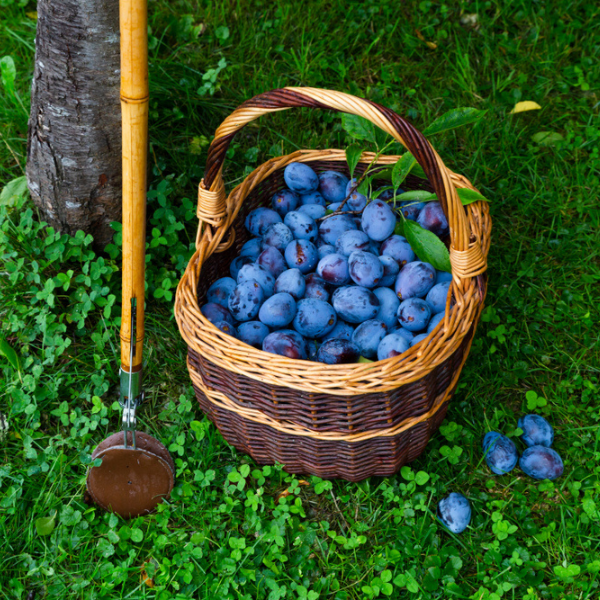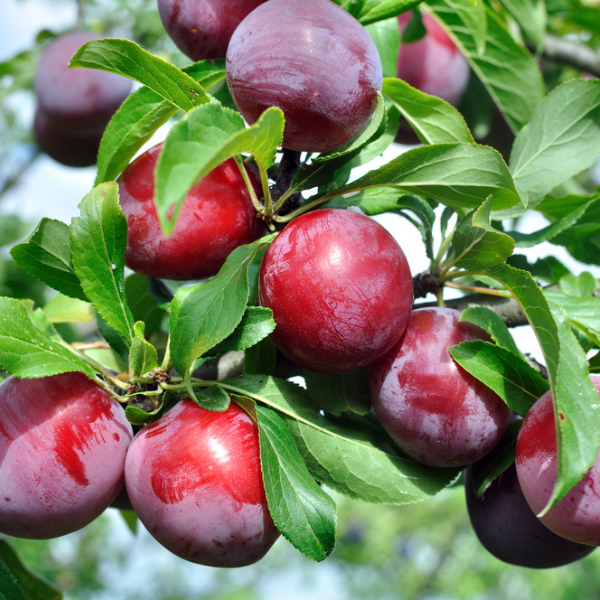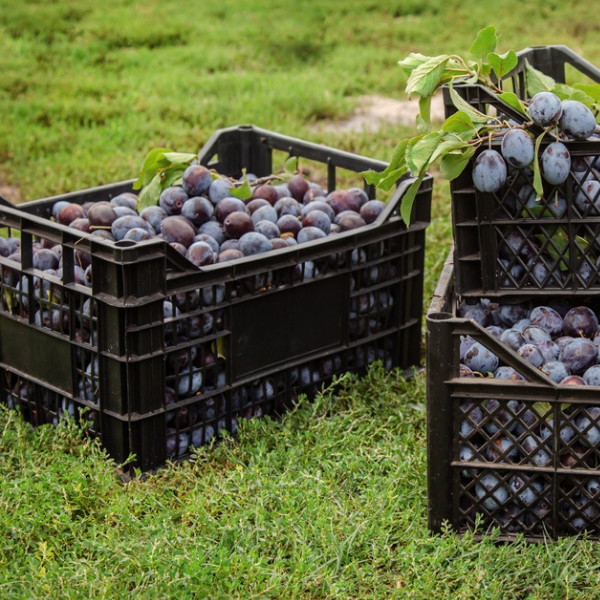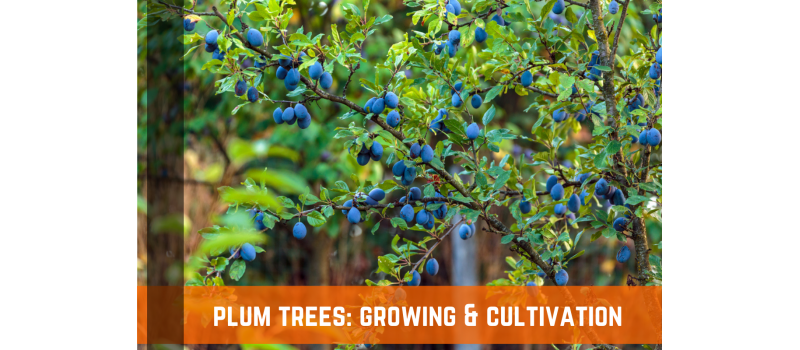Ever thought about growing plums? Plum trees are an excellent fruit tree for both novice and experienced gardeners. They are cold hardy, require little maintenance once established, and produce large quantities of delicious fruit.
With their rich red to purple leaves and abundance of white to light pink spring blossoms, purple-leaf plum trees, also known as cherry plum trees or flowering plum trees, can add appeal to any yard or garden. Purple-leaf plums are medium-sized deciduous trees that are mostly used for ornamentation.
Optimal Growing Conditions
Plums should only be grown in areas that have all of the following features. Otherwise, they may underperform.
Plum trees should be planted in loamy, well-drained soil. Plums do not grow well in clay soils or in situations where their roots are frequently damp.
Choose a planting place that receives full sun—at least 6 to 8 hours of direct sunlight. Optimal sunlight will encourage growth and abundant fruit yields.
Planting in low regions where frost may settle can cause damage to your trees. Plums are especially vulnerable to spring frosts because they flower so early, which can destroy blooms and result in poor fruiting.
Find a sheltering site, such as a south or west facing spot out of the wind, if possible. This will assist the plum tree in producing fruit.
How To Plant a Plum Tree
Plant plums in spring or early summer, before hot weather, as a container-grown or burlapped tree that is no longer dormant. When the time comes to plant your plum tree, do the following:
Prepare The Planting Location
Plum trees require full sun to yield fruit, so choose a planting location that receives at least six hours of sunlight per day. They prefer loamy, well-draining soil rich in organic materials as soil.
Depending on the variety of plum, your tree may be self-pollinating or require a second tree for cross-pollination—if your tree does not self-pollinate, find a location that allows for at least two mature trees. Trees of standard size require at least twenty feet of space.

Dig The Hole
The planting hole should be four to six inches bigger and deeper than the plum sapling's root ball; you don't want any of the roots to bend back on themselves when you put the tree in.
Place The Roots In The Hole & Spread
The surface line of the hole should be parallel to the soil line on the trunk. Place the sapling in the hole with the burlap still wrapped around it to keep the rootstock firm while you position the tree, then tear the burlap down the sides of the hole and lift the tree to remove all of the wrapping. Gently spread and place the roots without bending too much to encourage them to develop out from the tree.
Fill & Water
Soil and compost should be used to fill the hole. As you fill the trunk, gently shake it back and forth to assist the soil into the root system. After filling the hole, firm the soil in with your shoe to give the tree a strong base free of air pockets. Add a top layer of mulch around the tree to keep moisture in and weeds out. Water thoroughly after planting any type of fruit tree to help them settle into their new habitat.
Plum Tree Care & Maintenance
Watering
To encourage growth, water young plum trees heavily once a week throughout the first growing season. Water the plant deeply at the soil line, then allow the soil to dry (but not totally) before watering again. If rain is scarce, water your tree until mid-October to ensure it has enough moisture for the winter. Keep any dogs or pets away from newly planted trees or flowers.
Nutrition & Fertilizer
Fertilize young plum trees only after they have set a crop. Once established, fruit production necessitates year-round fertilization. If fruit set is good, fertilize with one pound calcium nitrate per tree. Reduce nitrogen application in the fall and winter to prevent stimulating new growth during those seasons.
General Care
Remember to prune your trees to keep them open to help reduce pests and diseases. Mulch around the trees in the spring to help manage weeds, but remove it in the late fall so that pests do not use it during the winter. In late April, you can also softly cultivate the soil surrounding your trees to kill any pests in the soil.
Rake away all rubbish and fallen trees in the fall. Consider wrapping or guarding the lower trunk of a young plum tree to protect it from winter damage. Keep an eye out for mouse or rabbit damage in the lower bark and branches; if this is a problem, you may need to install tree guards or fence in young trees with chicken wire for the winter.

How To Harvest & Store Plums
Plums are ready to harvest from late summer to October, depending on where you live. When plums are permitted to ripen on the tree, they have a better flavor. By applying gentle pressure with your fingers, you can tell when plums are ripe. When the skin of the fruit feels soft, it is ready to harvest.
Plums should easily come off the tree with a gentle twist of the fruit. Japanese plums are picked significantly earlier - store them in a cool area to ripen. Plums do not sweeten much after harvest, so select them when they are fully developed.
Plum Tree Varieties
Most people associate plums with petite, dark blue or purple fruits with a rich sweetness. But those aren't the only kinds of plums! There are hundreds of plum varieties growing around the world, many of which can be grown in your own backyard. Here are some of the most popular plum trees.
Kelsey Plum
The Kelsey plum is a distinct plum variety due to its green skin. It began in China, then moved to Japan, and lastly to the United States. The Kelsey plum was refined on American soil into the little green fruit we know today. They are exceptionally fruitful plants.
They can bear fruit in their second year if the conditions are favorable and a pollinator is present. The Kelsey plum is mild and sweet, with a solid firmness, making it ideal for eating raw or cooking.
June Plum
The June plum is a tasty, fast-growing type with enormous green fruit. Farmers and gardeners adore this plum tree because, despite its demanding character and stringent requirements, its enormous crop output makes it worthwhile.
June plums originated in the South Pacific before making their way to the Americas. While they were once rather huge in their native habitat, current June plums produced in the United States are considerably smaller.
June plum trees do not fare well in cooler climes because they developed to survive in tropical settings. These plums require as much heat and sun as possible.

Victoria Plum
The Victoria plum originated in Victorian England. This sweet purple fruit, named after the Queen and grown on British soil, is inextricably tied with British cuisine.
This plum tree is exceptionally cold tolerant and grows well in USDA zones one through three. It bears rich purple fruit with bright yellow flesh that is ideal for cooking and baking. The Victoria plum is ideal for preserves due to its moderate flavor that falls in between sweet and acidic.
Wild Plum
The wild plum is a low, almost shrublike tree found throughout Asia and the Americas. With its spreading branches, white blossoms, and deep purple fruit, it is a sight to behold.
Wild Plum trees are wonderful for growing in your yard or garden because they grow without any human maintenance. Wild plums are edible and tasty. These vivid purple fruits are quite tart, making them somewhat unpleasant to eat fresh. However, this means they're ideal for baking and jam!
French Plum
French plums are lovely blue-purple fruits native to the south of France. They are resilient and provide abundant yields year after year. People who have experienced French plums may struggle to explain their rich, distinct flavor. Suffice it to say, they have a soft flesh that is incredibly sweet and juicy, making them ideal for cooking, preserving, or simply eating raw.
In the spring, these attractive trees bloom with white flowers before bearing a big harvest of tiny fruit. The tasty plums are well worth the wait, despite their slow growth.

